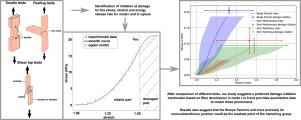Journal of the Mechanical Behavior of Biomedical Materials ( IF 3.9 ) Pub Date : 2021-01-13 , DOI: 10.1016/j.jmbbm.2021.104324 Baptiste Pillet , Pierre Badel , Pascal Edouard , Baptiste Pierrat

|
Lesions of the Musculotendinous Unit (MTU, i.e. tendon, myotendinous junction, muscle, aponeurosis and myoaponeurotic junction) are a common injury and a leading cause of functional impairment, long-term pain, and/or physical disability worldwide. Though a large effort has been devoted to macroscopic failure evaluation, these injuries suffer from a lack of knowledge of the underlying tissue-scale micro-mechanisms triggering such lesions. More specifically, there is a strong need for experimental data to better understand and quantify damage initiation and propagation on MTUs.
The present study presents original experimental data on muscle tissue extracted from the hamstring muscle group of rabbits under relevant mechanical solicitations up to rupture, revealing elementary micro-mechanisms and providing quantified values of elastic properties as well as initiation stress and energy release rate.
More specifically, tensile, peeling and shear lap tests were performed to explore cohesion of muscle tissue along the fibre direction or across fibres (mode I) and in shear (mode II), as well as at the muscle/tendon interface.
We show that muscle tissue is weaker in shear than tension (-value 0.01) and that the Biceps Femoris had the lowest energy release rate as calculated from mode I peeling tests (G = 0.23 ± 0.16 N/mm) compared to the Semi-Membranous (G = 0.53 ± 0.08 N/mm) and the Semi-Tendinous (0.45 ± 0.20 N/mm), and that this energy is the lowest at the musculotendinous junction.
Our study suggests a preferred damage initiation mechanism based on fibre decohesion in mode I or II and provides quantitative data to model these phenomena. Results also suggest that the Biceps Femoris and more precisely its musculotendinous junction could be the weakest point of the hamstring group.
These findings could be used as a basis to develop mechanical models (e.g. finite element) to better understand and predict the onset of hamstring lesions and help in preventing such events.
中文翻译:

绳肌在牵引力,剥离力和剪切力测试下破裂:兔的生物力学研究
肌腱组织单位(MTU,即肌腱,肌腱连接点,肌肉,腱膜和肌腱膜连接点)的病变是常见损伤,并且是导致功能障碍,长期疼痛和/或身体残疾的主要原因。尽管已经投入大量的精力进行宏观失效评估,但是这些损伤仍然缺乏对引发此类损伤的潜在组织规模微机制的了解。更具体地说,强烈需要实验数据以更好地理解和量化MTU上的损伤引发和传播。
本研究提供了从兔子的ham绳肌群中提取的肌肉组织的原始实验数据,在相关的机械刺激下直至破裂,揭示了基本的微观机制,并提供了弹性特性以及初始应力和能量释放速率的定量值。
更具体地,进行拉伸,剥离和剪切搭接测试以探究沿着纤维方向或跨纤维(模式I)和在剪切(模式II)以及在肌肉/肌腱界面处的肌肉组织的内聚力。
我们表明,肌肉组织的剪切力比张力弱(-值 0.01),并且根据模式I剥离测试计算,股二头肌的能量释放率最低(G = 0.23±0.16 N / mm),而半膜(G = 0.53±0.08 N / mm)和半膜能量(0.45±0.20 N / mm),并且在肌腱连接处的能量最低。
我们的研究提出了基于模式I或II中纤维脱粘的首选损伤引发机制,并提供了建模这些现象的定量数据。结果还表明,肱二头肌,更确切地说是其肌腱连接点可能是绳肌群的最弱点。
这些发现可作为建立机械模型(例如有限元)的基础,以更好地理解和预测绳肌损伤的发作并有助于预防此类事件。


























 京公网安备 11010802027423号
京公网安备 11010802027423号